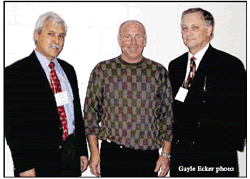|
|

“Extraordinary
opportunity” unites industry
for the health of all horses"
More than 30 delegates
from Ontario’s horse industry met in November to discuss a vision
for improved horse care and advancement in equine medicine. A round table
discussion was lead by the Honorable John Snobelen, Ontario’s Minister
of Natural
Resources, past Minister of Education, and avid cutting horse breeder
and trainer.
The meeting was organized to unveil the plans and progress of the University
of Guelph’s equine collaboration. The strategy encompasses research,
communications, education and training, and health service.
A vision of a dedicated equine performance-testing centre was also unveiled.
The Equine Performance Centre would provide state-of-the-art technologies
not currently
available, enhancing the diagnostic capabilities of the University’s
Large Animal Clinic. The plan encompasses a large indoor arena for lameness
evaluation, separate housing
for equine patients, and one-on-one communication and service to clients.
“Research is the driving force behind all of the service, communications,
and educational opportunities that we will offer,” said Ken Armstrong,
Director of the Equine
Research Centre and a key leader in the collaboration. Laurent Viel, Equine
Research Program Coordinator at Guelph, works closely with Armstrong on
behalf of the
initiative. Viel pointed out how under funded research and development
is in Ontario’s horse industry.
Equine research receives considerably less funding from industry than
other livestock industries (see below). “This leaves us understaffed
in some cases, and paralyses us to be
responsive to new and emerging issues, particularly disease outbreaks
or other crises,” said Viel. The initiative will be working hard
to improve the funding picture.
In summary the roundtable discussion, lead by a skilled chairman, had
a few clear messages
: • The industry sees a need to move forward as a cohesive
group on all fronts, with the health and well being of horses as the highest
priority.
• The industry would accept the equine initiative presented as taking
a leadership role for the whole industry. They would like the umbrella
group defined as a single identity.
• The industry appreciates the opportunity to consult on the plan,
and would like to revisit it to monitor the progress of the initiative.

(Left to right: Laurent Viel, John Snobelen, Ken Armstrong) “This
was an extraordinary opportunity to learn from many different perspectives
of the industry,” said Snobelen. “I don’t believe it has
ever been done, and I hope that it serves to move equine activities in
this province forward as a group. The equine industry is one of Ontario’s
best-kept secrets. It is important to our heritage and our future. It’s
time we let the world know about us.”
Gayle Ecker photo
| Program |
OMAFRA |
External |
Ratio |
| Dairy |
$3,287,490 |
$3,780,000 |
1:1.2 |
| Pork |
$2,360,000 |
$2,870,836 |
1:1.2 |
| Aquaculture |
$918,578
|
$1,021,549
|
1:1.1 |
| Poultry |
$1,877,406 |
$1,959,889 |
1:1 |
| Beef |
$3,813,754 |
$2,521,694 |
1:0.9 |
| Equine |
$930,000 |
$458,713 |
1:0.5 |
|

